Adding More Light to Our Lives
2023 Trends Make Interior Lighting the Focus of Any Space
In our homes, lighting can be one of those things we rarely think about until we find ourselves searching for a flashlight in the dark. But lighting can have a large impact on the aesthetic of your home. Small changes in your lighting fixtures—and even the bulbs you use—can dramatically change the look and feel of the spaces in your home.
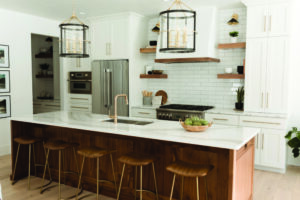
We may take it for granted, as it hangs above us or is tucked cleverly in the recesses of a room, but lighting can completely change the mood in a space and even affect the appearance of your chosen paint colors or wall coverings.
“I feel like it sets the theme and mood of the room,” Alicia Vanden Busch, design sales manager with The Saltbox Lighting and Home Furnishings in De Pere, explains. “It’s always the last thing that gets selected in the building process or remodeling process, but it’s the No. 1 thing you should focus on. It’s the sparkle, the jewelry, the whole vibe of your space.
“I feel like lighting can make or break a room; it can totally transform your room. Even if you want to just update one thing, changing a light can change everything.”
Appleton Lights the Way for the World
While we may look to lighting to simply improve our home’s aesthetic in 2023, it has a significant history tied directly to the Fox Cities. Electric lighting, which had an immeasurable affect on daily life in the late nineteenth century, was essentially born in Appleton—at the Hearthstone Historic House, the impeccable Queen Anne-style home located at 625 W. Prospect Ave.
In 1882, industrialist and entrepreneur Henry J. Rogers built the Victorian mansion for his wife, Cremora. It became the first residence in the world to be incandescently illuminated by a water-powered Western Edison Electric Light Company dynamo power station and an Edison Electric System.
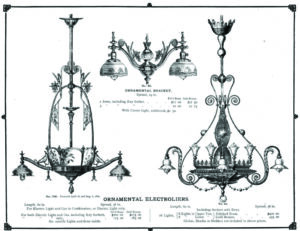
Lights for the home were carbonized bamboo filament bulbs and placed in fixtures called electroliers. They were furnished by Bergmann and Company, who was the exclusive source for lamp fixtures and hardware for Thomas Edison’s new incandescent lamps.
As local author and lighting historian Joan Rolfs explains, with the electrification technology came the need to dress it up and make it suitable for the home.
“Of course, when you bring electricity to the home, you want beautiful light fixtures,” she says. “So [Sigmund Bergmann] manufactured the very first electroliers and brackets for Thomas Edison. And those brackets and electroliers from 1882 are the only ones that are known to exist, right here in Appleton, Wisconsin.”
What’s Old is New Again
Whispers from the past are evident even in today’s lighting trends, Rolf explains.
“If Edison came back today, he would wonder if we made any changes in lighting because the lights that we use today, the bulbs that are accentuating our residences, show the filament,” she says.
Vintage-appearing or antique fixtures and textures are also trending.

“It’s interesting because as I was doing [a previous talk], there were some Tiffany lights that were incredible. And what did they show? The light bulb was protruding below the shade, just as they did in 1882. I would have never thought having light bulbs as popular as they are, as an accent in lighting,” she adds.
Statement Pieces
To make a big visual impact, Lori Jansen, interior designer and founder of Design House Interiors, LLC, uses lighting fixtures as statement pieces. Instead of three pendant lights over an island—a common sight in homes today—she encourages one or two larger fixtures for maximum impact. Don’t be afraid of unique materials or finishes.
“Lighting fixtures are playing a bigger role in room design because they can be that statement piece,” she states. “When it comes to the style, I think you have more flexibility with the finishes of the fixture, the shape of the fixture, and the materials. Whether it’s a linen shade on the light fixture, or a glass globe, you have so many options to choose from.
“Trend-wise, we’re also paying more attention to the function of the lighting in our home. Not just from the style aspect of the fixtures, but also how that lighting is used in a room.”
Rolfs, who was also an interior designer and the founder of the interior design department at Fox Valley Technical College, says she’s seen a trend in statement-making chandeliers. They’re works of art and would be stunning in a contemporary or eclectic interior, she notes.
“I really feel that the contemporary chandeliers are just incredible because I think they’re art works if you look at them in the stores and such. There was one called ‘Fireworks,’ made up of light bulbs of different sizes, with no shades at all. It’s really interesting how we’re using light bulbs to accentuate a room and put it together as a chandelier.”
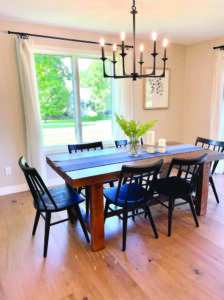
Rolfs says that some clients may be ready for a different look based on the trends that she’s seen emerge, and that’s more “country-cozy” or a “grandma and grandpa” look.
“Interiors will be softening, and we’ll have more of a cozy look, where people can come home and really relax and feel comfy-cozy in their home. That lighting can help make that happen.”
Wooden beads and even antlers in chandeliers are some of the materials she has seen used, while the art deco look is still popular, featuring fretwork.
Vanden Busch says the antique brushed gold is still popular for fixture finishes as well, which is different from the shiny gold made popular in the 1980s and ‘90s. Black is also still on trend.
“We’re seeing more alabaster glass or white glass as opposed to exposed bulbs now—more indirect lighting. We’re still doing polished nickel and chrome in bathrooms or mixing metals. I feel like you don’t have to do the same finish throughout the home. Just because your door handle is black, doesn’t mean you have to stick with black. You can mix in brushed nickel, you can mix in gold. Make it more of a copy of your personal style—you don’t have to be so matchy-matchy.”
The use of woven and more natural materials is also popular, adds Amy Hart, interior designer at The Saltbox Lighting.
“It’s bringing the outdoors in,” she explains.
With her clients, Jansen is using larger scale lighting and different types of fixtures that may be outside the norm to make a big impact in the space.
“The standard is having a wall fixture mounted over the mirror in the bathroom,” she explains. “To add some interest and to do something different in the space, I’ll do a hanging fixture from the ceiling centered over the sink. Or we will do wall sconces on each side of the mirror.”
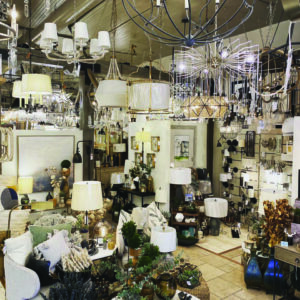
Another fixture she says she’s starting to use more are picture lights, above artwork and gallery walls.
“That’s another great spot to add some lighting and gives you a nice design element to that space.”
Budget-friendly Brilliance
Jansen says that one easy and affordable way to change lighting is by replacing or adding lamps you have in the home, whether it’s floor lamps or your side-table lamps. Believe it or not, changing the type of light bulb you use can also have a large impact on the space. Depending on what kind of bulbs you are using, even your paint color or wall coverings can look different.
A bulb in the range of 3,000 kelvin, often known commercially as “warm white,” outputs a more natural light and is the happy-medium of light bulbs.
“Older homes tend to have a more yellow bulb, whereas now we’re definitely trying to do a more natural light, instead of something that throws a yellow cast,” she explains.
In terms of fixtures, Hannah Gammons, interior designer with The Saltbox Lighting, says they carry a full range of brands in different price points and can work with anyone’s budget, starting with just one fixture and building from there over time.
“It could just be as simple as a new dining chandelier,” she says. “And then they could come back in six months and maybe update their kitchen pendants. You can go room by room to update things as the customer’s budget allows.”
“A lot of vendors like to copycat each other, so if you see something online, and it’s three times more than what you wanted to spend, we can source more vendors and styles that are similar for a better price point,” Vanden Busch adds.
“I think there is a lot of affordable lighting out there, where you can replace a few fixtures at a time,” Jansen agrees. “There are brands out there that are more expensive, but there are also options that are budget-friendly as well, that are current and would bring an updated look to the home.”
Do What Makes You Happy
Even as trends emerge and decline and we have seemingly countless online areas from which to be inspired, at the end of the day you’re the one who has to look at the lighting in your home. Don’t worry so much about having every fixture in your home from the same collection or match perfectly. In fact, Hart says The Saltbox Lighting has moved away from that because it allows them to design a space that’s customized to the customer, their home and design preferences. They make sure it all coordinates, but there is more freedom in choice.
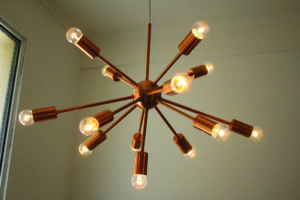
“If customers don’t know where to start, I always ask what the finishes are of their hardware, countertops, [and] flooring, or if they want to bring in a picture or have a picture of their space,” she says. “Sizing is always a big impact too. If we know your ceiling height, table size or countertop size… we want to be proportionate to everything else in your space.”
Jansen says lighting is more important today than it was even 10 years ago.
“I think back in the day people would pick out a fixture and you would have the same family of fixtures from your kitchen to your dining room. There wasn’t much difference. Nowadays we put way more thought into lighting, not only from the function of it, but also the look, the style and what it adds to the room.
“More than ever, lighting is a big part of that design process.”










Leave a Comment